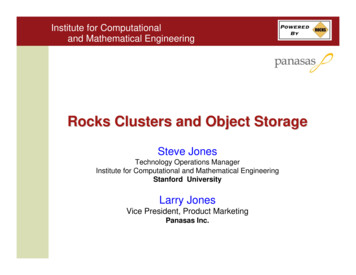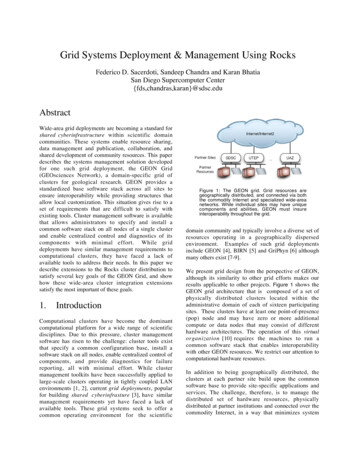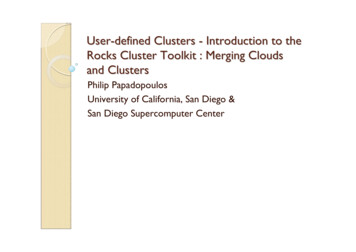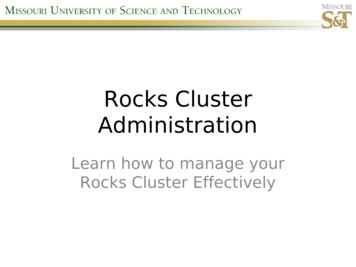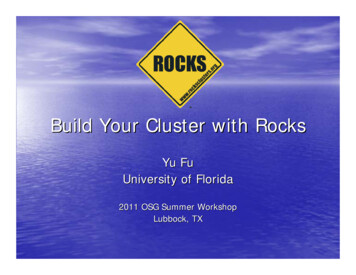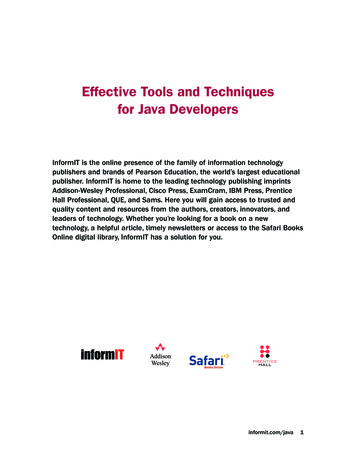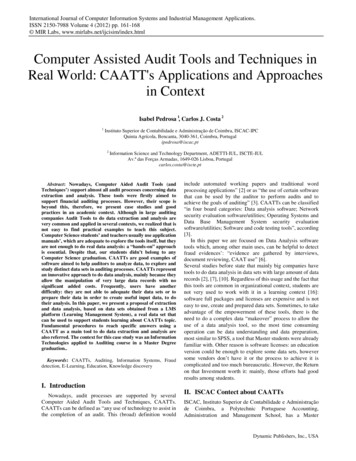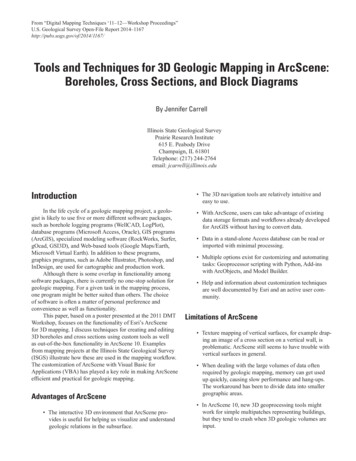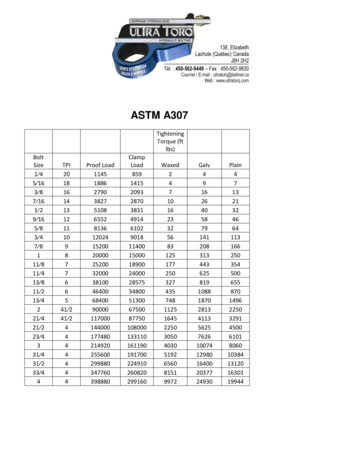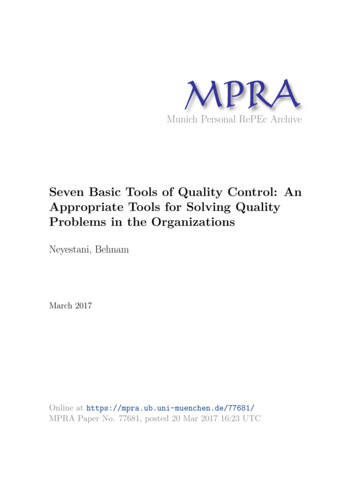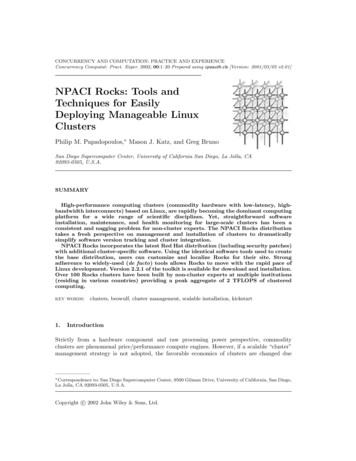
Transcription
CONCURRENCY AND COMPUTATION: PRACTICE AND EXPERIENCEConcurrency Computat: Pract. Exper. 2002; 00:1–20 Prepared using cpeauth.cls [Version: 2001/03/05 v2.01]NPACI Rocks: Tools andTechniques for EasilyDeploying Manageable LinuxClustersPhilip M. Papadopoulos, Mason J. Katz, and Greg BrunoSan Diego Supercomputer Center, University of California San Diego, La Jolla, CA92093-0505, U.S.A.SUMMARYHigh-performance computing clusters (commodity hardware with low-latency, highbandwidth interconnects) based on Linux, are rapidly becoming the dominant computingplatform for a wide range of scientific disciplines. Yet, straightforward softwareinstallation, maintenance, and health monitoring for large-scale clusters has been aconsistent and nagging problem for non-cluster experts. The NPACI Rocks distributiontakes a fresh perspective on management and installation of clusters to dramaticallysimplify software version tracking and cluster integration.NPACI Rocks incorporates the latest Red Hat distribution (including security patches)with additional cluster-specific software. Using the identical software tools used to createthe base distribution, users can customize and localize Rocks for their site. Strongadherence to widely-used (de facto) tools allows Rocks to move with the rapid pace ofLinux development. Version 2.2.1 of the toolkit is available for download and installation.Over 100 Rocks clusters have been built by non-cluster experts at multiple institutions(residing in various countries) providing a peak aggregate of 2 TFLOPS of clusteredcomputing.key words:1.clusters, beowulf, cluster management, scalable installation, kickstartIntroductionStrictly from a hardware component and raw processing power perspective, commodityclusters are phenomenal price/performance compute engines. However, if a scalable “cluster”management strategy is not adopted, the favorable economics of clusters are changed due Correspondenceto: San Diego Supercomputer Center, 9500 Gilman Drive, University of California, San Diego,La Jolla, CA 92093-0505, U.S.A.Copyright c 2002 John Wiley & Sons, Ltd.
2P. M. PAPADOPOULOS, ET AL.to the additional on-going personnel costs involved to “care and feed” for the machine. Thecomplexity of cluster management (e.g., determining if all nodes have a consistent set ofsoftware) often overruns part-time cluster administrators (who are usually domain-applicationscientists) to either of two extremes: the cluster is not stable due to configuration problems,or software becomes stale (security holes, known software bugs remain unpatched).While earlier clustering toolkits expend a great deal of effort (i.e., software) to compareconfigurations of nodes, Rocks makes complete OS installation on a node the basic managementtool. With attention to complete automation of this process, it becomes faster to reinstall allnodes to a known configuration than it is to determine if nodes were out of synchronizationin the first place. Unlike a user’s desktop, the OS on a cluster node is considered to be softstate that can be changed and/or updated rapidly. This is clearly diametrically opposed tothe philosophy of configuration management tools like Cfengine [2] that perform exhaustiveexamination and parity checking of an installed OS. At first glance, it seems wrong to reinstallthe OS when a configuration parameter needs to be changed. Indeed, for a single node thismight seem too heavyweight. However, this approach scales exceptionally well (see Table I)making it a preferred mode for even a modest-sized cluster. Additionally, how many files canreally be updated while all services on a node remain online? Some files can be changed whilethe system is running, but the line is not clear. Clearly, fundamental changes to the operatingenvironment require a reboot (e.g., new kernel, new glibc) and changes to any shared object orservice require that all processes that are using the file or service in question must terminatebefore the update can occur to avoid a program crash.One of the key ingredients of Rocks is a robust mechanism to produce customized (withsecurity patches pre-applied) distributions that define the complete set of software for aparticular node. Within a distribution, different sets of software can be installed on nodes(for example, parallel storage servers may need additional components) by defining a machinespecific Red Hat Kickstart file. A Kickstart file is a text-based description of all the softwarepackages and software configuration to be deployed on a node. By leveraging this installationtechnology, we can abstract out many of the hardware differences and allow the Kickstartprocess to autodetect the correct hardware modules to load (e.g., disk subsystem type:SCSI, IDE, integrated RAID adapter; Ethernet interfaces; and high-speed network interfaces).Further, we benefit from the robust and rich support that commercial Linux distributions musthave to be viable in today’s rapidly advancing marketplace.Wherever possible, Rocks uses automatic methods to determine configuration differences.Yet, because clusters are unified machines, there are a few services that require “global”knowledge of the machine – e.g., a listing of all compute nodes for the hosts database andqueuing system. Rocks uses a MySQL database to define these global configurations andthen generates database reports to create service-specific configuration files (e.g., DHCPconfiguration file, /etc/hosts, and PBS nodes file).Since May of 2000, we’ve been addressing the difficulties of deploying manageable clusters.We’ve been driven by one goal: make clusters easy. By easy we mean easy to deploy,manage, upgrade and scale. We’re driven by this goal to help deliver the computational powerof clusters to a wide range of users. It’s clear that making stable and manageable parallelcomputing platforms available to a wide range of scientists will aid immensely in improvingthe parallel tools that need continual development.Copyright c 2002 John Wiley & Sons, Ltd.Prepared using cpeauth.clsConcurrency Computat: Pract. Exper. 2002; 00:1–20
NPACI ROCKS3In Section 2, we provide an overview of contemporary clusters projects. In Section 3, weexamine common pitfalls in cluster management. In Section 4, we examine the hardware andsoftware architecture in greater detail. In Section 5, we detail the management strategy whichguides everything we develop. In Section 6, you’ll find deeper discussions of the key NPACIRocks tools, and in Section 7, we describe future Rocks development.2.Related WorkIn this section we reference various clustering efforts and compare them to the current stateof Rocks. Real World Computing Partnership - RWCP is a Tokyo-based research groupassembled in 1992. RWCP has addressed a wide range of issues in clustering fromlow-level, high-performance communication [17] to manageability. Their SCore softwareprovides semi-automated node integration using Red Hat’s interactive installationtool [18], and a job launcher similar to UCB’s REXEC (discussed in Section 4.1). Scyld Beowulf - Scyld Computing Corporation’s product, Scyld Beowulf, is a clusteringoperating system which presents a single system image (SSI) to users through the Bprocmechanism by modifying the following: the Linux kernel, the GNU C library, and someuser-level utilities. Rocks is not an SSI system. On Scyld clusters, configuration is pushedto compute nodes by a Scyld-developed program run on the frontend node. Scyld providesa good installation program, but has limited support for heterogeneous nodes. Becauseof the deep changes made to the kernel by Scyld, many of the bug and security fixes mustbe integrated and tested by them. These fundamental changes require Scyld to take onmany (but not all) of the duties of a distribution provider. Scalable Cluster Environment - The SCE project is a clustering effort beingdeveloped at Kasetsart University in Thailand [19]. SCE is a software suite that includestools to install compute node software, manage and monitor compute nodes, and abatch scheduler to address the difficulties in deploying and maintaining clusters. Theuser is responsible for installing the frontend with Red Hat Linux on their own, thenSCE functionality is added to the frontend via a slick-looking GUI. Installing andmaintaining compute nodes is managed with a single-system image approach by networkbooting (a.k.a., diskless client). System information is gathered and visualized withimpressive web and VRML tools. In contrast, Rocks provides a self-contained, clusteraware installation built upon Red Hat’s distribution. This leads to consistent installationsfor both frontend and compute nodes, as well as providing well-known methods for usersto add and customize cluster functionality. Also, Rocks doesn’t employ diskless clients,avoiding scalability issues and functionality issues (not all network adapters can networkboot). On the whole, SCE and Rocks are orthogonal – the two groups are discussing plansto meld the base OS environment installation features from Rocks with the sophisticatedmanagement suite from SCE. Cfengine - Cfengine [2, 3] is a policy-based configuration management tool that canconfigure UNIX or NT hosts. After the initial operating environment is installed byCopyright c 2002 John Wiley & Sons, Ltd.Prepared using cpeauth.clsConcurrency Computat: Pract. Exper. 2002; 00:1–20
4P. M. PAPADOPOULOS, ET AL.hand or another tool (cfengine doesn’t install the base environment), cfengine is usedto instantiate the initial configuration of a host and then keep that configurationconsistent by consulting a central policy file (accessed through NFS). The central policyfile is written in a cfengine-specific configuration language (which resembles makefilesyntax) that allows an administrator to define the configuration for all hosts withinan administration domain. Each cfengine-enabled host consults this file to keep itsconfiguration current.To deal with hardware and software heterogeneity, cfengine defines classes to delineateunique characteristics. Open Cluster Group - The Open Cluster Group has released their OSCAR toolkit [14].OSCAR is a collection of common clustering software tools in the form of tar files thatare installed on top of a Linux distribution on the frontend machine. When integratingcompute nodes, IBM’s Linux Utility for cluster Install (LUI) operates in a similar mannerto Red Hat’s Kickstart. OSCAR requires a deep understanding of cluster architecturesand systems, relies upon a 3rd-party installation program, and has fewer supportedcluster-specific software packages than Rocks.3.PitfallsWe embarked on the Rocks project after spending a year running a single, Windows NT,64-node, hand-configured cluster. This cluster is an important experimental platform that isused by the Concurrent Systems Architecture Group (CSAG) at UCSD to support research inparallel and scalable systems. On the whole, the cluster is operational and serves its researchfunction. However, it stays running because of frequent, on-site, administrator intervention.After this experience, it became clear that an installation management strategy is essentialfor scaling and for technology transfer. This section examines some of the common pitfalls ofvarious cluster management approaches.3.1.Disk CloningThe CSAG cluster above is basically managed with a disk cloning tool, where a model nodeis hand-configured with desired software and then a bit-image of the system partition ismade. Commercial software (ImageCast in this case) is then used to clone this image onhomogeneous hardware. Disk cloning was also espoused as the preferred method of systemreplication in [15]. While clusters usually start out as homogeneous, they quickly evolve intoheterogeneous systems due to the rapid pace of technology refresh as they are scaled or as failedcomponents are replaced. As an example, over the past 18 months, the Rocks-based “Meteor”cluster at SDSC, has evolved from a homogeneous system to one that has seven different typesof nodes, two different CPU architectures, manufactured by three vendors with three differenttypes of disk-storage adapters. Further, a handful of these machines are dual-homed Ethernetfrontend nodes, and most compute nodes have Myrinet adapters, but not all.Node heterogeneity is really a common state for most clusters and being able to transparentlymanage these small changes makes the complete system more stable. Additionally, while theCopyright c 2002 John Wiley & Sons, Ltd.Prepared using cpeauth.clsConcurrency Computat: Pract. Exper. 2002; 00:1–20
NPACI ROCKS5software state of a machine can be described as the sequential stream of bits on a disk, amore powerful and flexible concept is to use a description of the software components thatcomprise a particular node configuration. In Rocks, software package names and site-specificconfiguration options fully describe a node. A framework of XML files is used to describe corecomponents of the base operating environment. Each component specifies one or more RedHat packages and optionally a post installation script. Components are drawn together basedon the type of system one wishes to install. Although we have used this idea to break downRed Hat Kickstart files into a more managable form, the end result for node installation is aRed Hat compliant text-based Kickstart file. By applying standard programming techniquesto monolithic Kickstart files we have created a single framework of XML files to describe allvariants of hardware (e.g., x86 and IA-64) and software (e.g., compute, frontend, NFS server,web server) in the Meteor cluster.3.2.Installing Each System “By Hand”Installing and maintaining nodes by hand is another common pitfall of neophyte clusteradministrators. At first glance it appears manageable, especially for small clusters, but asclusters scale and as time passes, small differences in each node’s configuration negativelyaffects system stability. Even savvy computer professionals will occasionally enter incorrectcommand line sequences, implying that the following questions need to be answered: “What version of software X do I have on node Y?”“Software service X on node Y appears to be down. Did I configure it correctly?”“When my script attempted to update 32 nodes ran, was node X offline?”“My experiment on node X just went horribly wrong. How do I restore the last knowngood state?”The Rocks methodology eliminates the need to ask these questions (which rotate generallyaround consistency of configuration).3.3.Proprietary Installation Programs and Unneeded Software CustomizationProprietary and/or specialized cluster installation programs seem like a good idea whenpresented with the current technology of commercial distributions. However, going downthe path of building a customized installer, means that many of the hardware detectionalgorithms that are present in commercial distributions must be replicated. The pace ofhardware updates makes this task too time-consuming for research groups and is reallyunneeded “wheel reinvention”. Proprietary installers often demand homogeneous hardwareor, even worse, a specific brand of homogeneous hardware. This reduces choice for a clusteruser and can inhibit the ability to grow or update a cluster. While Rocks does not have all thebells and whistles of some of these installers, it is hardware neutral. Also, specialized clusterinstallation programs often don’t incorporate the latest software, a pitfall which is described,and addressed, later in this paper.Unneeded software customization is another pitfall. Often, cluster administrators feelcompelled to customize the kernel to support high-performance computing. For us, the stockCopyright c 2002 John Wiley & Sons, Ltd.Prepared using cpeauth.clsConcurrency Computat: Pract. Exper. 2002; 00:1–20
6P. M. PAPADOPOULOS, ET AL.Front-end Node(s)Public wer DistributionGigabit NetworkSwitching Complex(Ethernet addressable units as option)Fast-EthernetSwitching ComplexFigure 1. Rocks hardware architecture. Based on a minimal traditional cluster architecture.Red Hat kernel has served us well – it has supported various hardware platforms and deliveredacceptable performance to a variety of scientific applications (e.g., GAMESS [22], AMBER [23],NAMD [24] and NWChem [25]).We acknowledge that kernel customization can increase application performance and isnecessary in order to support unique hardware. For these cases, we have expanded upon RedHat’s additions to the standard Linux kernel makefile that includes an rpm target. To includea new kernel RPM into Rocks, the cluster administrator crafts a .config file, rebuilds thekernel RPM (with make rpm), copies the resulting kernel binary package back to the frontendmachine and binds it into a new distribution (using rocks-dist, described in Section 6). Thenthe new kernel RPM is instantiated on all desired nodes by simply reinstalling them.4.Rocks Cluster Hardware and Software ArchitectureTo provide context for the tools and techniques described in the following sections, we’llintroduce the hardware and software architecture on which Rocks runs.Figure 1 shows a traditional architecture commonly used for high-performance computingclusters as pioneered by the Network of Workstations project [4] and popularized by theBeowulf project [1]. This system is composed of standard high-volume servers, an Ethernetnetwork, power and an optional off-the-shelf high-performance cluster interconnect (e.g.,Myrinet or Gigabit Ethernet). We’ve defined the Rocks cluster architecture to contain aminimal set of high-volume components in an effort to build reliable systems by reducingthe component count and by using components with large mean-time-to-failure specifications.In support of our goal to “make clusters easy”, we’ve focused on simplicity. There isno dedicated management network. Yet another network increases the physical deployment(e.g., more cables, more switches) and the management burden, as one has to manage theCopyright c 2002 John Wiley & Sons, Ltd.Prepared using cpeauth.clsConcurrency Computat: Pract. Exper. 2002; 00:1–20
NPACI ROCKS7management network. We’ve made the choice to remotely manage compute nodes over theintegrated Ethernet device found on many server motherboards. This network is essentiallyfree, is configured early in the boot cycle, and can be brought up with a very small systemimage. As long as compute nodes can communicate through their Ethernet, this strategy workswell. If a compute node doesn’t respond over the network, it can be remotely power cycled byexecuting a hard power cycle command for its outlet on a network-enabled power distributionunit. † If the compute node is still unresponsive, physical intervention is required. For thiscase, we have a crash cart – a monitor and a keyboard.This strategy has been effective, even though a crash cart appears to be non-scalable.However, with modern components, total system failure rates are small. When balanced againsthaving to debug or manage a management network for faults, reducing network complexityappears to be “a win”. The downside of using only Ethernet, is that an administrator is “inthe dark” from the moment the node is powered on (or reset) to the time Linux brings up theEthernet network. Our experience has been if Linux can’t bring up the Ethernet network, eithera hardware error has occurred with a high probability that physical intervention is necessary,or a central (common-mode) service (often NFS) has failed. Hardware repairs require nodesto be removed from the rack. For a common-mode failure, fixing the service and then powercycling nodes (remotely) solves the dilemma. To minimize the time an administrator is inthe dark, we’ve developed a service that allows a user to remotely monitor the status of aRed Hat Kickstart installation by using telnet (see Section 6.3). With this straightforwardtechnolog
consistent and nagging problem for non-cluster experts. The NPACI Rocks distribution takes a fresh perspective on management and installation of clusters to dramatically simplify software version tracking and cluster integration. NPACI Rocks incorp
